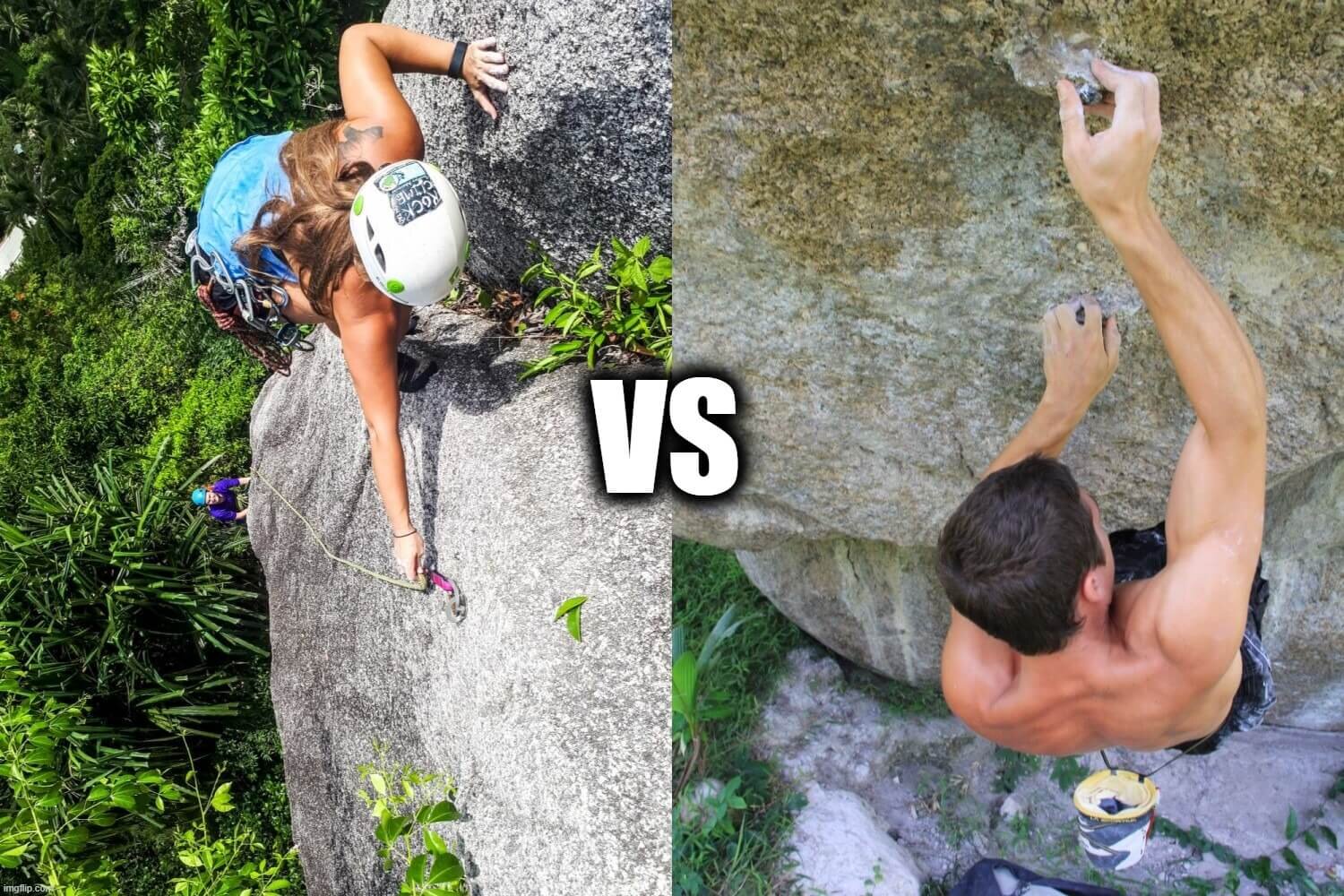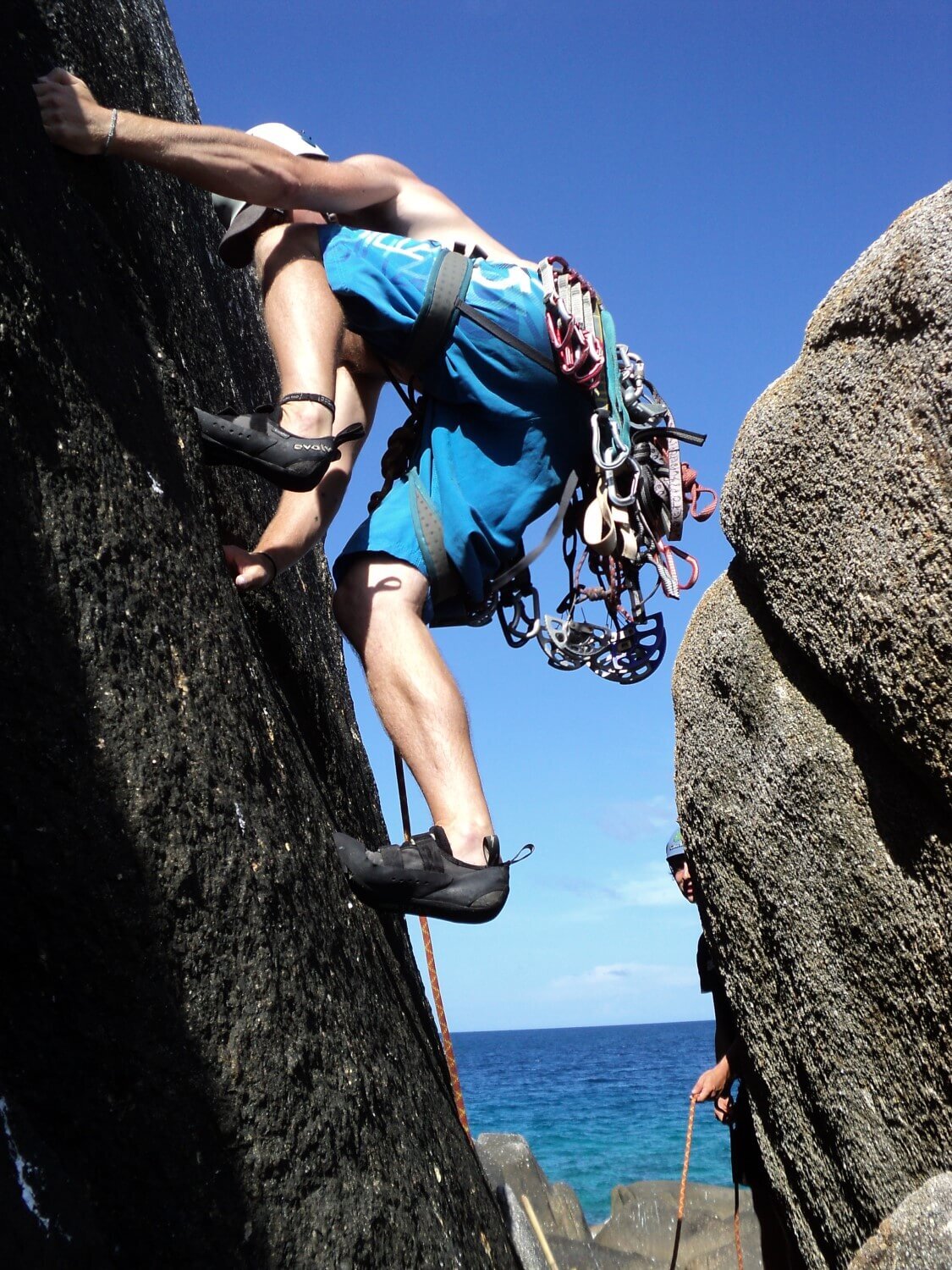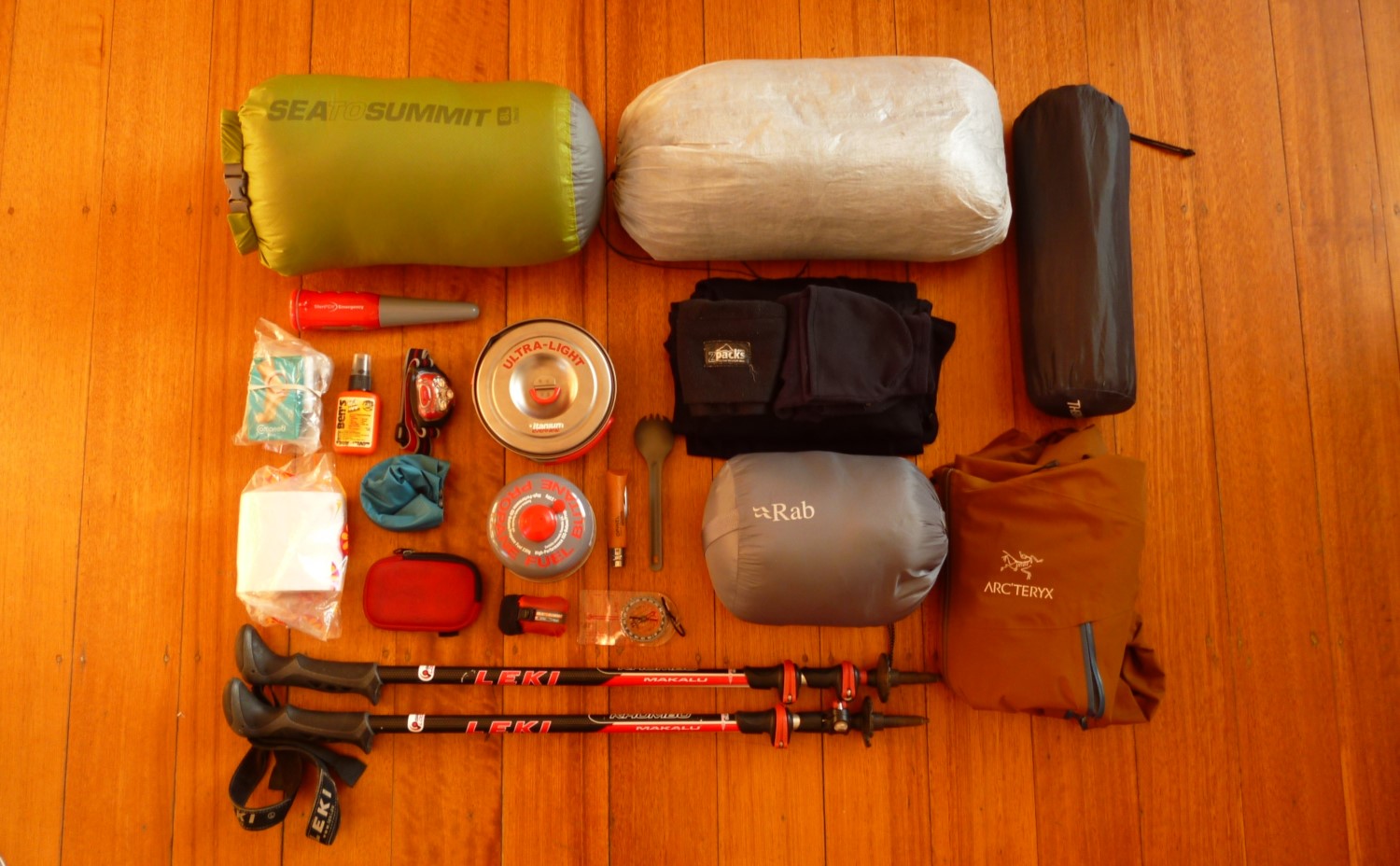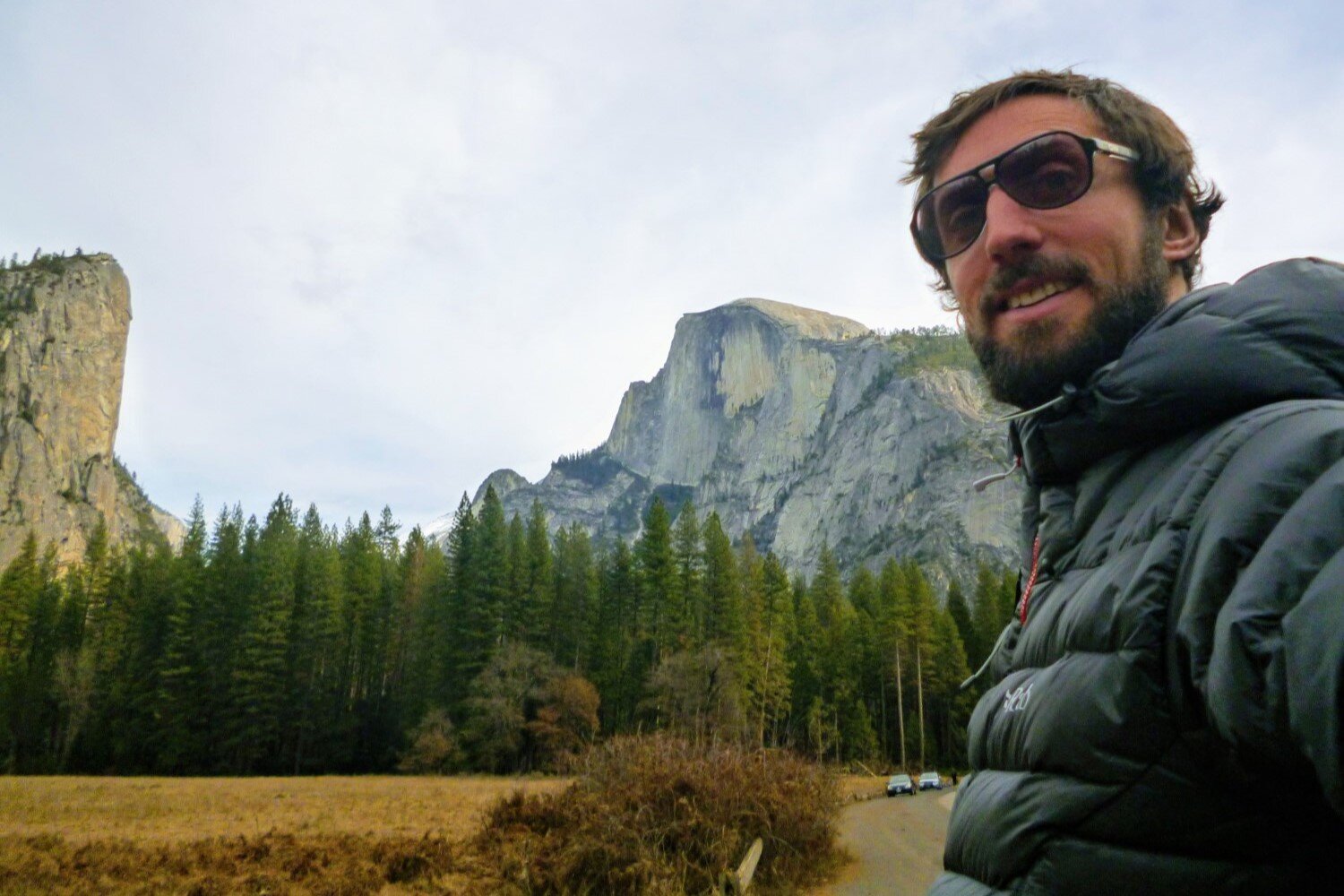BOULDERING vs ROCK CLIMBING — WTF is the difference?
JUMP TO: WHAT IS ROCK CLIMBING / BOULDERING AS A SUB-SPORT / KEY DISTINCTIONS / GRADES & DIFFICULTY / COMPETITIONS / WHO IS IT SUITED TO / LEARNING, PROGRESSING & IMPROVING / SUMMARY
Author: Tim Severino
Most of us have seen photos of rock climbers high above the earth, dangling from ropes, pushing their way ever upwards…
However, not all rock climbing activities happen so high above the ground.
Bouldering is also an increasingly popular sport – and although it also takes place on rock and overlaps with rock climbing in its technique, bouldering also has nuances of its own… not least its proximity to the ground and absence of ropes!
But beyond the ropes (or the absence of them) what really are the differences between rock climbing and bouldering?
In this article we dig into the history of each as well as the differences in skills, training, grades, equipment, safety considerations, and more.
So whether you are a seasoned climber looking for variety, or a newbie looking to get started in one or both, our guide below should help you understand each sub-sport and the best way to get started!
WHAT IS ROCK CLIMBING?
Simply put, rock climbing is where a person climbs – generally up, but also down and sideways! – on some rocks.
But as this activity has evolved over time, it has developed into various sub-sports or types of climbing, most of which use a rope as part of the protection and require a belayer or climbing partner.
If you are interested in getting into roped rock climbing – either indoors or outdoors – then there are several possible types of climbing you can undertake:
Top Rope uses a fixed rope anchor at the top of the cliff and so is the safest form of roped climbing.
TOP ROPE CLIMBING: Top rope climbing uses a single rope, which goes up and through an anchor at the top of the cliff (for outdoor) or climbing wall (for indoor).
The climber ties into one end of the rope, and to make them safe, the “belayer” uses some equipment on the other end of the rope to support the climber. As the climber goes up, the belayer pulls the rope to keep it tight and uses a brake to stop the climber from falling. Once the climber reaches the top, they are lowered slowly back down to the ground.
Top rope can be done indoors or outdoors, and because the rope is always positioned above the climber and secured using a fixed anchor, it is super safe and accessible to beginners.
SPORT (LEAD) CLIMBING: In sport climbing, the climber climbs up the rock face with a trailing rope (i.e. lead climbing). As they climb, they clip the rope into pre-placed protection – usually in the form of metal bolts. The height of a fall iterates between smaller and larger as they climb, depending on how far they’ve climbed past the most recent protection point.
Sport climbing is logistically easier than top rope since it doesn’t require a fixed rope to be set up ahead of the climb. But it is usually done by more experienced climbers and requires a lot more mental focus than top rope, due to the increased risk of a fall. But like top rope, sport climbing can be done indoors or outdoors.
Trad climbing requires the climber to carry their own protection and install it as they climb.
TRADITIONAL (LEAD) CLIMBING: Traditional – or “trad” – climbing is essentially the same as sport climbing, however the climber must carry and place their own protection as they climb. For instance, instead of having metal bolts to connect to, they must place temporary protection in cracks in the rock. This slows things down considerably.
Compared to sport climbing, trad climbing carries additional risks and is more “exploratory” in style. Plus, it can only be done outdoors. However, since it doesn’t require fixed bolts it isn’t limited to certain locations.
MULTI-PITCH / BIG WALL: Multi-pitch is another form of lead climbing, but where the climbing pair completes one pitch after another. Because the climbers can complete multiple pitches, they can travel higher and higher until they reach the top of the wall, regardless of its height. Due to the multi-pitch nature, it only occurs outdoors. However each pitch could be sport climbing or trad.
AID CLIMBING: Aid climbing it generally a big wall or multi-pitch climb, but using ladders or other equipment to assist the climber. Aid climbing is often used when supporting other climbers, or when filming for instance.
FREE SOLOING: In free soloing the climber ascends without ropes. But unlike bouldering (which we discuss next), the climber is ascending high on the rock face! Only a certain type of professional climber does free soloing, as it is extremely dangerous and essentially has a zero margin for error.
So where does that leave bouldering?
BOULDERING AS A SUB-SPORT
Bouldering started as a way for climbers to train without having to rig up ropes. They would find rock boulders near their campsite and practice hard moves, but remain low to the ground to decrease the risks of injury.
This approach – of remaining close to the ground, but pushing the technical limits of the moves, became increasingly popular. So popular that today bouldering is essentially its own sub-sport, quite distinct from rock climbing. Shoes, training, and even the type of person who enjoys it, are all subtly different when it comes to bouldering compared to other types of rock climbing.
INDOOR BOULDERING: Most major cities now have boulder gyms as it’s a great way for people to climb safely. Imagine a big warehouse with climbing walls full of colored holds all around the edges and on structures in the middle but the height is limited to 5m. There are big heavy mats on the ground everywhere – to soften your fall – and signs on the walls indicating the grades.
You find your grade, climb up, drop down, and repeat. You can pump out loads of these in an hour, by yourself (i.e. no need for a belayer or climbing partner!) and work on improving your techniques as you go.
OUTDOOR BOULDERING: When bouldering outdoors, you need big soft pads (known as “crash pads”) that you must carry to the boulder locations. It’s generally a much slower pace outdoors since you need a spotter to assist you if you fall. The rocks can vary in height, and unless you climb in an established place and have a guidebook, it can be difficult to discern what grades the boulders are. Because there is only limited protection, it is more dangerous outdoors and you can’t do it by yourself (since you need a spotter). But the obvious upside is that it’s outside on nature’s rocks!
KEY DISTINCTIONS BETWEEN BOULDERING & CLIMBING
While many people enjoy both roped climbing and bouldering, many people tend to focus on one or the other. This is because they require you to focus on different aspects in order to progress your abilities. Plus, there are differences in aspects such as equipment, grading, or risks.
Strength, balance & endurance
This is one of the biggest distinctions between the two sports.
Outdoor rock climbers require a good combination of strength, balance, and endurance to succeed in their endeavors. Plus, a climber tends to use their feet and overall balance to move themselves upwards, while ensuring their safety by using protection as they go.
On the other hand, a boulder problem is short and physical, so a boulderer will maximize the use of their core and upper body strength, at the expense of endurance. In bouldering, the feet are still used, but often as a counterweight to the arms, to get the body up and over the boulder problems.
Equipment
A rock climber generally carries a decent amount of equipment – mostly for safety reasons. They also require the knowledge and ability to use it, not just for their own safety, but also for their climbing partner or team.
And depending on how high they intend to climb, this equipment can add up – both in terms of its complexity and its weight!
Bouldering by stark contrast does away with everything – except for your shoes (for performance) and a chalk bag (to keep your hands dry). For many, this simplicity is one of the attractive characteristics of bouldering.
Protection & risk
Unless they are free soloing – which is rare! – a rock climber will always be protected in some form. Even when climbing above the last piece of protection, it will be calculated that if they fall, they will still be caught and not hit the ground. This means that, aside from protection failing or not being used correctly, rock climbing is a relatively safe sport.
For the boulderer, crash pads (outside) or foam mats (inside) offer the only safety protection, apart from the spotter who stands underneath the boulderer and attempts to stop their head from hitting the ground as they fall. It might come as a surprise to some, but there are far more injuries with outdoor bouldering than there are with indoor bouldering or any type of indoor or outdoor roped climbing.
Training
There are some pretty major differences to consider when it comes to learning, training, and progression. Climbers tend to focus on learning skills alongside working on their climbing ability. As they progress from top rope, to sport leading, to trad leading, and then on to multi-pitch, they require a steady flow of new skills, knowledge, and experiences to tackle their new challenges safely.
Whereas anyone can boulder – and performance almost directly equates to strength, balance, and problem-solving skills. In fact, some amazing boulderer’s don’t even know how to top rope belay as it’s simply not needed.
GRADES AND DIFFICULTY
ROCK CLIMBING: When we rock climb, we go up what’s called a ‘route’. Most routes are 30m (100ft) or less, however these routes can be stacked up on top of each other – that’s when we get the “multi-pitch” climb.
Each route has information about it: when it was made, by whom, who first climbed it, the amount of protection required, the height and the grade.
Due to its length, a climbing route will usually have easier parts and harder parts. The overall grade is determined by the hardest moves in the route (and many guidebooks indicate where that is), so a climber can expect to be pushed on parts of the climb, but not necessarily the whole climb.
There are many different climbing grade systems out there.
One of the most common is the Yosemite Decimal System (YDS) in the US. But the UK also have two aimed at traditional climbing, the French have a well-known sport climbing one, and the UIAA (International Climbing and Mountaineering Federation / Union Internationale des Associations d’Alpinisme) moves into mountaineering. There are also many other grading systems in use around the world too, for example those from Brazil and South Africa.
BOULDERING: In bouldering the word ‘route’ is not used, and instead we refer to the ‘problem’. So in common language it’s now called a ‘boulder problem’ not a ‘climbing route’.
This isn’t just terminology either – it actually reflects how the boulder is climbed. Often, a boulder problem has 3 to 8 moves that are all at the same grade level – and flow into each other – meaning you are pushed hard at the grade limit for the entire problem.
They are also called ‘problems’ as often it takes some trial and effort (and multiple attempts!) to work out your series of moves required to complete it. Plus, it’s too short to be called a proper climbing route!
Bouldering has its own grading system called the ‘V-scale’. It starts at VB, then is numbered V0, V1, V2, and so on up to V16.
COMPETITIONS
ROCK CLIMBING: Rock climbing completions tend to fall into two categories – speed climbing and lead climbing. Both are on artificial walls so are lacking in the ‘authentic’ rock feel.
Speed climbing and lead climbing are the two types of competition events for roped climbing. Photo credit: Simon Legner.
Speed climbing uses top rope and is about getting to the top of the wall as fast as possible. Whilst lead climbing involves climbing a route that gets harder as the climber ascends (very different from a graded route), with the winner being the climber who safely reaches the highest climbing hold.
BOULDERING: In many ways, bouldering has pushed climbing further into the public eye. But no more so than with competitions.
Any bouldering gym can run a competition, simply by setting up a number of progressively more difficult boulder problems. Anyone can join these types of competitions, and – depending on the competition – the winner is the person that climbs the hardest problem, or the quickest doing so.
Olympic rules, which are being adopted across the world in national competitions are slightly different. Under the Olympic rules, climbers are given a time limit of four minutes during which they can complete as many attempts as they want.
Each competitor's score is determined by the overall number of problems finished and the number of attempts needed. These can easily be set up indoors or in any stadium with an artificial wall. And they can attract large crowds!
While they are popular and all three (bouldering, speed climbing, lead climbing) are now in the Olympics – it’s the bouldering competitions where we see true power, strength, and agility. It is also bouldering competitions that offer the greatest accessibility, for people to try it out for themselves.
WHO IS BOULDERING OR CLIMBING MOST SUITED TO?
BOULDERING: People who enjoy using short bursts of energy, building strength, and like to rapidly push their grades higher, will be drawn to bouldering.
Bouldering is well suited to those who like short bursts of energy and rapidly pushing their grades.
Some might be drawn to the simplicity and lack of equipment involved. Others might be drawn to the challenge of using (and developing) your raw upper body strength.
Bouldering is also well suited to those who like fast feedback – a boulder problem is much shorter than a multi-pitch climb!
ROCK CLIMBING: One of the things we love about climbing is that – with a bit of training – anyone can have a go. However, not everyone enjoys it – usually it’s the height that is the issue! (But occasionally other things).
People who are adventurous, love to explore, and enjoy being outdoors will often find outdoor roped climbing something they enjoy immensely.
You will need to be interested in learning skills like belaying, as well as interested in learning about safety and the technical aspects of the gear.
LEARNING, PROGRESSING & IMPROVING
ROCK CLIMBING: People who want to learn how to rock climb, generally either learn from a friend or take a course at a gym or an outdoor school (which are usually close to quality crags that they have helped establish or manage).
There is a natural progression of both skills and ability that most climbers undertake. While paying for courses can seem expensive (and learning from your friends is much less so!), taking at least one course with a climbing instructor – e.g. a sport lead course – will help ensure you have been taught to top rope correctly and will help fine tune your actual climbing ability. Taking at least one professional course will also help fill in the knowledge gaps that learning from friends can lead to.
As for training, some climbers like to walk up hills to gain leg strength and build endurance. Or do gym circuits for strength during the weekdays and then get out onto the rocks on the weekends. Going on a climbing trip where you can camp or stay right near a crag for a week (or more!) and climb every day is a fantastic way to improve your climbing abilities too, not to mention a great way to have a holiday!
BOULDERING: Bouldering on the other hand, requires next to no instruction and everyone can have a go straight away. Indoors is more accessible and safer than outdoors, and most major cities have indoor bouldering gyms these days.
Many would say the best training for bouldering is – bouldering! Since it’s such a physical activity, after an hour or so you really feel like you have had a good workout. And the muscles you target are the exact muscles you need to improve your form!
Both indoor and outdoor bouldering gyms are becoming a more common sight in major cities — like The Cliffs At DUMBO in Brooklyn, NYC. Photo credit: Caroline Culler.
SUMMARY
Bouldering is a form of climbing, no doubt, but the lack of equipment and training required make it super accessible. It’s a great way to learn climbing moves or improve your balance and strength – all things that will help progress your roped climbing as well.
So even if you love the outdoors, the occasional indoor boulder session might be super beneficial for you – so get to your local boulder gym and try it out!
Either way, hopefully you found this comparison article useful. So whether you plan to try one, the other, or both – you know what to expect!
MORE INFORMATION
If you loved this article, then you'll likely love reading some of our other climbing content:
Or perhaps check out our Gear Reviews page or our hiking Destination Guides.























